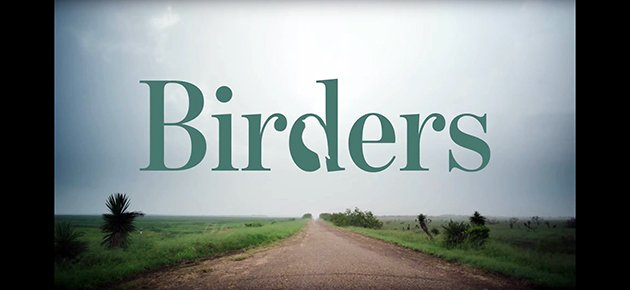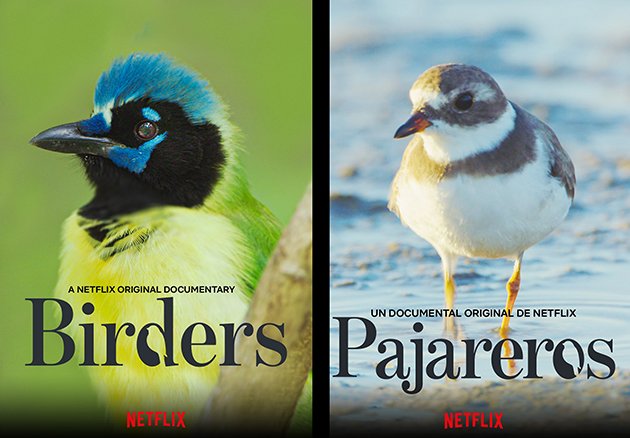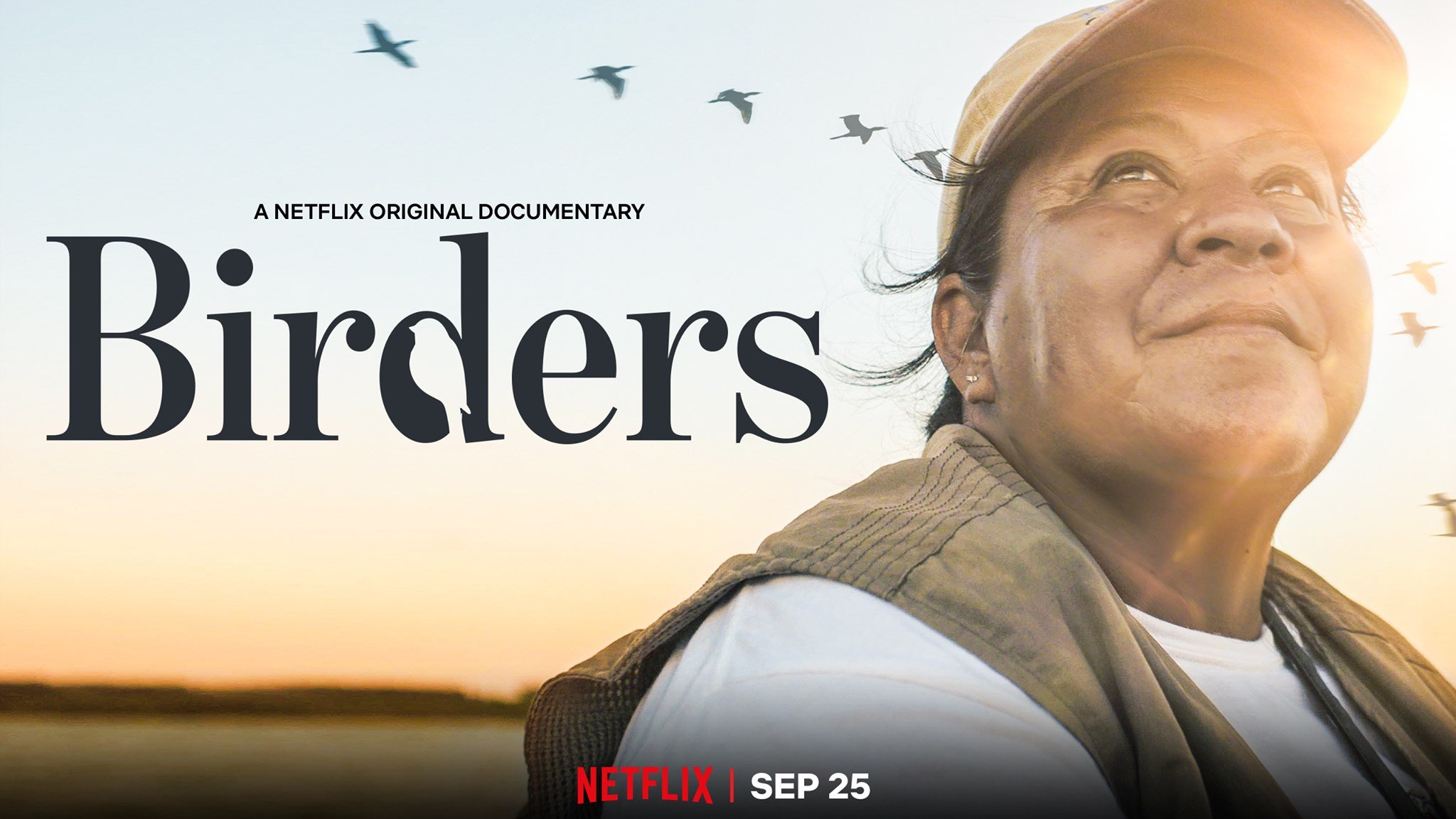
The first shot of Birders is of a helicopter. It’s an official-looking helicopter, photographed flying in the air at eye level, as if we’re next to it. Then, a long shot looking down of the Rio Grande delta, green and brown, but mostly green, bisected by a continuing, curving brown line. We see a closer shot of the river itself, hawks flying across the span, and then we see that brown line again, close up, a wall of brown panels filling the right side of the screen, continuing into the distance, no end in sight, while a white pick-up truck drives parallel to it at the far left of the screen. A voice says, “This is an incredible place for migrants.” The shot changes, and now the wall is on the left, and we’re moving along a dirt road. “Where they stop and water and get some food before they continue their migration,” the voice continues, and, if you’re not a birder you could be excused from a sense of confusion–is this a film about migrant birds or migrant people?
The next two shots give the answer: a close-up of a stunningly beautiful Scissor-tailed Flycatcher and a long shot of hundreds of Mississippi Kites in flight. The voice, which we soon learns belongs to wildlife photographer Richard Moore, exclaims, “Migration is on!” and then adds, “The border wall is no barrier to birds.” So, it is established: this is a film about migrant birds and the people who work to protect them in south Texas and northern Mexico. And, “the border wall” is a character in that story. But, surprisingly, we never hear a direct critical word about politics or the current administration.
Instead, the film focuses on the importance of the Rio Grande delta as a migratory corridor and the different ways in which ornithologists, biologists, bird surveyors, banders, sanctuary guides, hawk counters, and birders contribute to creating safe places for migrating and residential birds (and also insects, reptiles, and mammals). And, it shows us the birds in brief, non-captioned close-ups of songbirds and owls and soaring overhead pans of migrating hawks and waders. A little over a half-hour in length, Birders (not to be confused with another Netflix release, Birders: The Central Park Effect or the The Birders, a documentary about Colombian birds and birding) is a film of quiet advocacy that says a lot visually and through the words of its passionate participants.
The film starts in the lower Rio Grande Valley (or, as Moore calls it, “deep South Texas”), showing in small vignettes the work of people such as Moore, who is working to establish a wildlife corridor for migrating birds and animals, and bird bander Mark Conway, who speaks to the importance of this corridor (one of the best things about the YouTube trailer for this film are the comments from Conway’s former high school students, who testify in delight about how his banding field trips helped them appreciate nature). We also hear, interestingly, from meteorologists at the U.S. National Weather Service Forecasting station in Brownsville, and from Keith Hackland, owner of the Alamo Inn, who speaks to the economic power of visiting birders (they spend, he says, half a billion dollars a year spent in the area and sustain 6600 jobs). We encounter a family participating in a hawk watch count at Bentsen-Rio Grande Valley State Park; birder and activist Madeleine Sandefur, who introduces us to Sabal Palms Sanctuary in Brownsville, on the south side of a border wall built in 2009; and birders who are actually birding, identifying an oriole (Altamira rather than Hooded). Joyce Hamilton, one of the birders and also a local activist, explains the core issue of why the plan for ‘the wall’ is a problem, despite Moore’s earlier statement that walls are not barriers to birds. The planners want to eradicate the vegetation of both sides of ‘the wall.’ “Vegetation means wildlife,” Hamilton says, “If that’s destroyed, then their habitat is gone.” Leaving us with the unspoken question, with habitat gone, will there be a migratory corridor?
At this point, midway through the film, the background music changes from country to Mexican, the language from English to Spanish, and we find ourselves traveling to the other side of the Rio Grande/Río Bravo. It’s an exciting juxtaposition, preceded by two very different opinions –the young birder who wistfully hopes to visit Mexico one day and observe its wildlife, and the older man who thinks the country has become too dangerous. The music (” Se divisan las praderas y mi rio, Y los canteres de los pájaros hermosos /I can see the prairies and my river, and the songs of the beautiful birds…”) tells us which side the filmmaker is on.
In Mexico we visit with Esteban Berroneos, a bird guide at El Cielo Biosphere Reserve, Tamaulipas, who mourns the decrease in United States visiting birders while calling in an owl (a Mottled Owl, I think); Juanita and Meli Dapa, mother and daughter bird monitors at Laguna Madre y Delta del Rio Bravo, who delight in the hundreds of Black-necked Stilts as they boat through the delta; the young bird banders of the River of Raptors banding station; the busy mix of hawk counters and visiting birders at the famed River of Raptors Hawk Watch in Chichicaxtle; and Braulio Malaga, bird monitor at the Las Tuxlas Biosphere Reserve, who strongly identifies with the returning migrants. These last three locations are in Veracruz, far from the border but on the migration flyway.
The hawkwatch scenes are joyous, crowded with people and birds. There are more stories here than can be contained in a few scenes–the story of counter Angel Peña who’s been with the hawkwatch since 1997 seems particularly intriguing–which is perhaps why this particular section feels a little disjointed. American tourists are not in short supply, and the camera lingers over stacks of hawk guides and rows of expensive optical equipment as we overhear the chatter of counters and birders in Spanish and English. The experiences of children observing birds, touched on in the U.S. section, reaches an exciting climax here as a young boy is given a counter and binoculars and tries to count the thousands of hawks.
Birders is directed by Otilia Portillo Padua of Mexico, and was funded by a grant from the Sundance Institute. It isn’t clear why Otilia Portillo Padua decided to make this film; there is frustratingly little material available on the film’s background from Netflix, the film’s distributor/streamer. The answer may lie more in the work of executive producer Gael Garcia Bernal, co-founder of the Mexican Ambulante Film Festival and the actor who co-presented the Academy Award for Best Animated Feature Film with the words, “As a Mexican, as a migrant worker, as a human being, I’m against any form of wall that separates us.”* Portillo Padua’s previous documentary, the 2012 Diario a Tres Voces, was well reviewed and made the festival circuit, but it was of the creative, personal documentary subspecies. Still, this may account for the very specific, personal nature of Birders‘ people scenes. There is a sense of people speaking to you, as opposed to the stilted interview question-and-answer I see in many documentaries.
The film has an overall simplicity that makes it easy to overlook its deliberate construction and attention to detail. As I noted above, half the film takes place in the United States and half in Mexico. Gender of speakers is also carefully divided; there are as many women speaking and working as men. Every location is labeled in English and Spanish and a small map shows us its location in relationship to the border. Most speakers are also identified, though it sometimes took me two viewings to see a label, they tend to be in a corner so as not to distract from the cinematography. Captioning is available in Spanish and English. The birds are not identified unless the speaker is talking about them, and I think that is by design. The focus is on the people and their activities. (This does open up a great identification opportunity for birders watching the film, however.)
Birders is a lovingly photographed, carefully structured film about bird workers and enthusiasts on both sides of the Rio Grande/Río Bravo border. There are many ways the filmmakers could have gone about making this film; rather than filming protests and quoting lots of statistics, they have focused on people and birds, creating a quiet advocacy that will hopefully intensify the impact of their message. The film can only be seen on Netflix at the current time. Hopefully, it will be more widely available in the future. I think birders will enjoy viewing it.
* “Gael Garcia Bernal On Mexico’s Plan to Save Its Image With Documentary Films,” IndieWire, May 10, 2017, https://www.indiewire.com/2017/05/gael-garcia-bernal-interview-ambulante-2017-documentaries-1201814738/
Birders
Otilia Portillo Padua, director.
Daniela Alatorre, Elena Fortes, Producers
Gael García Bernal, Executive Producer
Produced by No Ficcion films, 37 minutes.
Currently available for viewing on Netflix (released on Netflix Sept. 25, 2019)













Leave a Comment